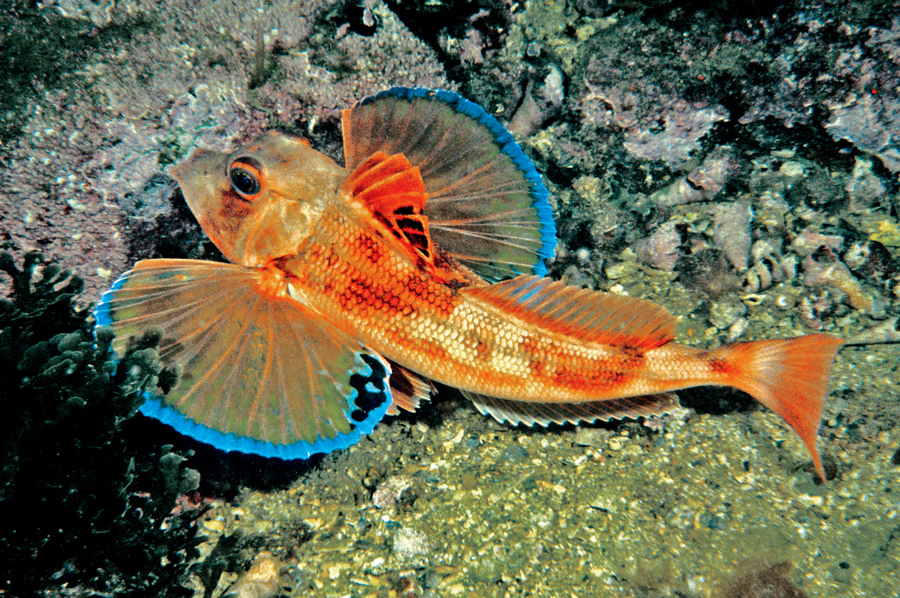Butterfly Gurnard, Lepidotrigla vanessa (Richardson 1839)
Other Names: Bight Gurnard, Spiny-sided Butterfly-Gurnard, Spiny-sided Gurnard

A Butterfly Gurnard, Lepidotrigla vanessa. Source: Rudie H. Kuiter / Aquatic Photographics. License: All rights reserved
Summary:
A reddish gurnard becoming white below, with dark blotches along the back, a black spot on the first dorsal fin (reddish-black in large adults), broad red bands on the dorsal and caudal fins, and the roof of the mouth yellow posteriorly. The inner surface of the pectoral fin is green to reddish with a blue margin and a black spot near the inner corner of the outer edge.
Cite this page as:
Bray, D.J. 2023, Lepidotrigla vanessa in Fishes of Australia, accessed 24 Apr 2024, https://fishesofaustralia.net.au/home/species/3755
Butterfly Gurnard, Lepidotrigla vanessa (Richardson 1839)
More Info
|
Distribution |
Off Wooli, New South Wales, to the Great Australian Bight, southeastern Western Australia, including around Tasmania. Inhabits soft sediment areas on the upper continental slope. |
|
Features |
Dorsal fin X–XI + 16–17; Anal fin 16–17; Caudal fin 11; Pectoral fin 11 + 3; Pelvic fin I, 5; Lateral line scales 64–69. Profile of snout slightly concave, hump developing in adults; interorbital slightly to moderately depressed; no groove above and behind the eye except in juveniles; bony rostrum with a small but prominent spine at each corner, bordered by smaller spines in young; scales ctenoid, firmly attached, absent from chest and belly anteriorly; lateral line scales not enlarged but with distinct spines; caudal fin with concave margin; pectoral fins reaching well beyond anal-fin origin. |
|
Colour |
Reddish above, white below with dark blotches on back; roof of mouth yellow posteriorly; 1st dorsal fin with black spot, spot suffused with red in large adults; 2nd dorsal and caudal fins with broad red bands; inner surface of pectoral fins green to reddish with blue margin and black spot near inner corner of outer edge. |
|
Feeding |
Feeds mostly on benthic crustaceans such as crabs, shrimps and small fishes. |
|
Etymology |
The species is named for the butterfly genus Vanessa, presumably in reference to the large colourful pectoral fins that may resemble butterfly wings. |
|
Species Citation |
Trigla vanessa Richardson 1839, Proc. Zool. Soc. Lond. 7: 97. Type locality: Port Arthur, Tasmania (as Van Diemen's Land). |
|
Author |
Bray, D.J. 2023 |
|
Resources |
Butterfly Gurnard, Lepidotrigla vanessa (Richardson 1839)
References
Coleman, N. 1980. Australian Sea Fishes South of 30ºS. Lane Cove, NSW : Doubleday Australia Pty Ltd 309 pp. (as Paratrigula vanessa)
Coleman, N. & Mobley, M. 1984. Diets of commercially exploited fish from Bass Strait and adjacent Victorian waters, southeastern Australia. Australian Journal of Marine and Freshwater Research 35(5): 549-560. https://doi.org/10.1071/MF9840549
Gomon, M.F. 1994. Family Triglidae. pp. 494-505 figs 442-450 in Gomon, M.F., Glover, C.J.M. & Kuiter, R.H. (eds) The Fishes of Australia's South Coast. Adelaide : State Printer 992 pp. 810 figs.
Gomon, M.F. & Last, P.R. 2008. Family Triglidae. pp. 508-514 in Gomon, M.F., Bray, D.J. & Kuiter, R.H. (eds) Fishes of Australia's Southern Coast. Sydney : Reed New Holland 928 pp.
Kuiter, R.H. 1993. Coastal Fishes of South-eastern Australia. Bathurst : Crawford House Press 437 pp.
Kuiter, R.H. 1996. Guide to Sea Fishes of Australia. A comprehensive reference for divers and fishermen. Sydney, NSW, Australia : New Holland Publishers xvii, 434 pp.
May, J.L. & Maxwell, J.G.H. 1986. Field Guide to Trawl Fish from Temperate Waters of Australia. Hobart : CSIRO Division of Marine Research 492 pp.
McCoy, F. 1878-1890. Prodromus of the zoology of Victoria; figures and descriptions of the living species of all classes of the Victorian indigenous animals. Government Printer, Melbourne. 20 decades in 2 vols. (Decade 1, pp. 17-19) See ref at BHL
Neira, F.J., Miskiewicz, A.G. & Trnski, T. 1998. Larvae of temperate Australian fishes: laboratory guide for larval fish identification. University of Western Australia Press. 474 pp.
Park, J.M., Troy, F., Gaston, T.F. & Williamson, J.E. Resource partitioning in gurnard species using trophic analyses: The importance of temporal resolution. Fisheries Research 186 (2017): 301–310 http://dx.doi.org/10.1016/j.fishres.2016.10.005
Richards, W.J. 1992. Comments on the genus Lepidotrigla (Pisces: Triglidae) with descriptions of two new species from the Indian and Pacific oceans. Bulletin of Marine Science 51(1): 45-65. See ref online
Richardson, J. 1839. Account of an interesting collection of fish formed at Port Arthur in Van Diemen's Land. Proceedings of the Zoological Society of London 7: 95-100. See ref at BHL
Richardson, J. 1842. Descriptions of Australian fish. Part 1. Transactions of the Zoological Society of London 3(1): 69-131 figs 4-6 See ref at BHL
Whitley, G.P. 1958. Descriptions and records of fishes. Proceedings of the Royal Zoological Society of New South Wales 1956–57: 28-51 figs 1-12 [as Paratrigla (Aoyagichthys) vanessa] See ref at BHL







